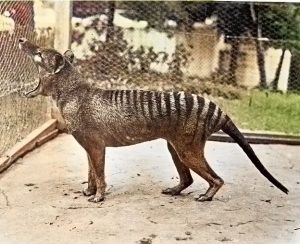Thylacine
 Thylacinus cynocephalus
Thylacinus cynocephalus
Size
Body length – 100 to 130 cm
Tail length – 50- to 65-cm
Weight – 15 to 30 kg
Males were larger than females on average.
Physical description
- The fur was yellowish brown, with 13 to 19 dark bars on the back and rump.
- Hind legs were longer than the forelegs.
- Tail was very thick at the base, tapering evenly to a point.
- The thylacine was able to open its jaws to an unusual extent: up to 80 degrees and had 46 teeths.
- The tail vertebrae were fused to a degree, with resulting restriction of full tail movement.
- Female thylacine had a pouch with four teats, but unlike many other marsupials, the pouch opened to the rear of its body and carried two to four young at a time.
Interesting fact
- It was the largest carnivorous marsupial with the general appearance of a medium-to-large-size dog, except for its stiff tail and abdominal pouch.
- The thylacine had been found on the Australian mainland and New Guinea and was confined to Tasmania only in historic times.
- It was relatively shy and nocturnal, but was a formidable apex predator, that hunted at night for wallabies and birds.
- Due toconvergent evolution, it displayed an anatomy andadaptations similar to the tiger and wolf of the Northern Hemisphere, despite being unrelated.
- The thylacine was one among the only two marsupials to possess pouch in both sexes: the other (still extant) species is the water opossum from Central and South America.
- The pouch of the male thylacine served as a protective sheath, covering the external reproductive organs.
- This animal is supposed to have hunted in small family groups, with the main group herding prey in the general direction of an individual waiting in ambush.
- Thylacine probably appeared about 2 million years ago, and was the sole modern representative of the family Thylacinidae, which is known otherwise by several fossil species.
- The last known live thylacine was believed to have died at Tasmania’s Hobart Zoo in 1936. Threatened Species Day is held in Australia each year on Sept. 7 to commemorate the anniversary of the animal’s death.
Causes for extinction
- Competition with the dingo (omnivorous Australian dog)probably led to its disappearance from the mainland.
- It was widely hunted in Tasmania by European settlers because it was considered a threat to the domestic sheep introduced to the island.
- Disease and human encroachment into its habitat is also supposed to be the reason for its extinction.
